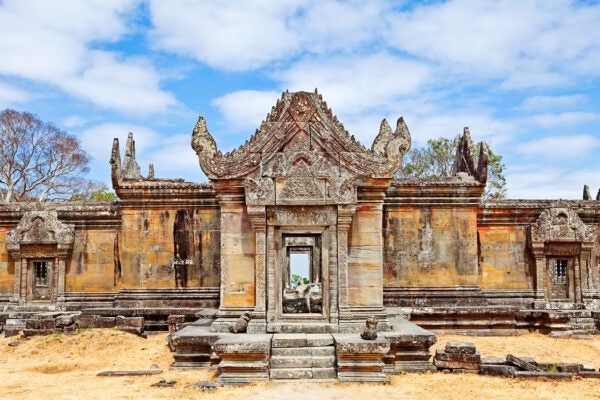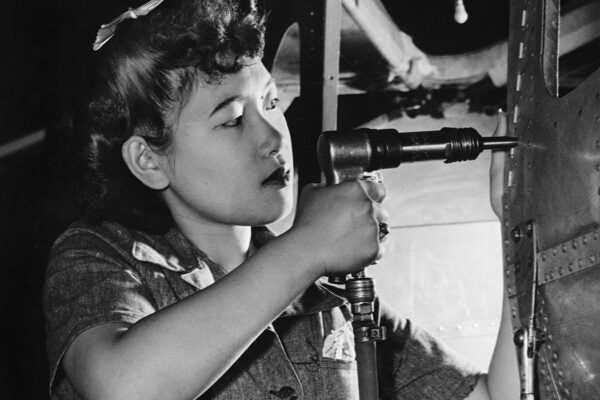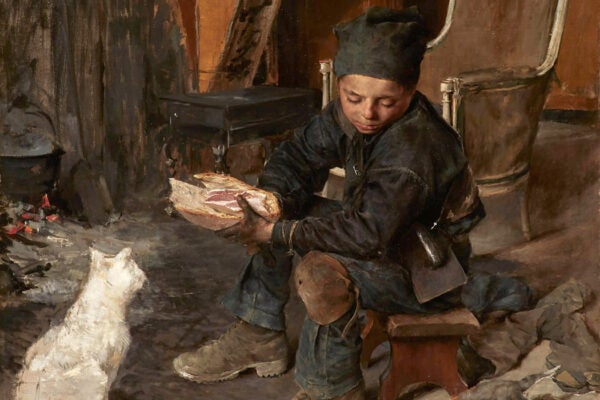Her formerly snow-white clothes were stained red. She had cropped her long hair and tied it into a knot above her head. Her hands held a heavy halberd. Kawahara Asako had just killed her mother-in-law and young daughter to prevent them from falling into the enemy’s hands. Drenched in their blood, she marched onto the battlefield, ready to die defending her home.
Kawahara fought in the Battle of Aizu, named for a region in the northern part of Japan. It was one of the deadliest conflicts of the Boshin War, the civil conflict that shook Japan from 1868 to 1869. It saw the Imperial forces of Emperor Meiji face the Tokugawa shogunate, the military regime that had governed Japan since 1603. The shogunate, to which the Aizu were allied, wanted to preserve Japan’s insularity, its traditional way of life, and curtail Western influences. The emperor, on the other hand, was spearheading the country’s transformation into a modern nation-state in a revolution from above.
Get Our Weekly Newsletter
The Meiji Restoration ended Japan’s seclusion policy and opened the country up to foreign powers, hastening change in almost all areas of life. But fundamental societal transformations rarely go smoothly. At stake was nothing less than the very soul and future of Japan.
When the imperial forces invaded the Aizu region in 1868, they did so to cement their control of Japan. That October, the emperor’s troops, outnumbering the shogunate soldiers and in possession of better supplies, made quick progress in taking settlements. After sustaining heavy losses, the Aizu population was ordered to barricade themselves in nearby Tsuruga Castle.

Kawahara Asako was among several Aizu women determined to defend the castle against invaders. Their education had prepared these women for war. Diana E. Wright points out that they received extensive combat training and were educated to be “equally skilled in the ways of the pen and the sword.” These warriors stand in a long tradition of women in Japan who joined battles alongside their male counterparts and immortalized themselves as Onna-Bugeisha, literally, “female martial arts masters.”
Empress Jingū, said to have ruled between 201 and 269 CE, is one of the country’s earliest female warriors. As the legend goes, Jingū led an invasion of the Korean peninsula while pregnant with the future Emperor Ojin. Almost a thousand years later, Tomoe Gozen, likely the most famous Onna-Bugeisha in history, fought in the Genpei War (1180-1185), serving as principal commander in several battles. A fierce fighter, Gozen led 300 female samurai into battle against 2,000 enemies and was one of only five warriors to survive. Two years later, she oversaw 3,000 men. The medieval epic Tale of the Heike, one of the seminal texts of Japanese literature, describes her as:
a fearless rider whom neither the fiercest horse nor the roughest ground could dismay, and so dexterously did she handle sword and bow that she was a match for a thousand warriors, and fit to meet either god or devil.
The line that separates fact from fiction in Tomoe’s story is fine and her exploits are bound to be exaggerated. However, Steven T. Brown points out there is little disagreement that Tomoe was on the battlefield, though she was not medieval Japan’s only female fighter. In 1201, Hangaku Gozen led an army of 3,000 men in the Kennin Rebellion.
Beginning in the Middle Ages, the samurai class developed out of the medieval warrior class. Originally, samurai were soldiers serving the emperor. As the Japanese military class began to exert power and came to rule from the 12th century onwards, the samurai joined the ruling elite. In the Edo Period (1603 – 1867), they formed the highest social class. Samurai came to be defined, says Douglas R. Howland, “in terms of hereditary status, a right to hold public office, a right to bear arms, and a ‘cultural superiority,’ upheld through educational preferment.” In other words, samurai were born, not made. All samurai—male and female—followed a strict code of conduct that emphasized loyalty and honor, and all of them received military training.
Yet each samurai’s family determined how much training their warrior would have. Clan members often saw their daughters’ military education as spiritual preparation for their roles as wives and mothers, emphasizing endurance and discipline in the domestic realm. Unsurprisingly, then, the vast majority of samurai-class women never took part in battle.
Yet not all battle training was symbolic. The Aizu were celebrated for their martial skills and often engaged in military operations. Aizu women were taught to prioritize what they defended: above all they were to safeguard their lord and domain. After that, they were to protect their families. Their training was put to the test in their defense of Tsuruga Castle.
Facing the advancing enemy army in the fall of 1868, the Aizu women had four options: flee to the countryside, retreat to Tsuruga Castle, commit suicide, or fight. Though some killed themselves to prevent capture, the vast majority retreated, making ammunition, supporting the fighters, and caring for the wounded. Around 20 to 30 women, many without dependents, formed the Jōshigun, their own army unit, to defend the castle.
The existence of the Jōshigun was not a foregone conclusion. Founded by Nakano Kōko, its driving force was Nakano Takeko, Kōko’s daughter. Takeko, age 22, was skilled in halberd techniques, but her participation in battle was complicated. She and other women were initially barred from joining a battle battalion lest the attackers see their participation as a sign of weakness. Takeko threatened suicide in protest, when a newly arrived commander conceded and allowed the women to form their own unit.
Takeko, her mother, and her sister Masako along with other women, cut their hair short, donned men’s trousers and straw sandals, and armed themselves. On the battlefield, they were almost indistinguishable from male counterparts.
With swords and halberds in hand, the women met their enemies, who were armed with guns. The women were under no delusion they would survive or escape capture, though they succeeded in killing many Meiji soldiers in hand-to-hand combat.
Contemporaneous sources describe Takeko in action on the field of combat, “with her tied-back hair, trousers, and steely eyes [she] radiated an intense male spirit and engaged the enemy troops, killing five or six with her halberd.” In spite of her fearlessness, she did not survive the day. At the peak of battle, she took fire in the chest. Eventually, the surviving Jōshigun retreated into Tsuruga Castle where they met up with Kawahara Asako and took cover as the castle lay under siege for 30 days.
In Tsuruga, the situation grew dire. Food and medicine ran out, and the wounded and dead seemed to occupy every surface. The Aizu women nevertheless continued resisting. A 60-year-old woman was the victim of an attempted robbery at the hands of an enemy soldier when she set out to procure food for the wounded. She killed him and went on her way back to the castle, unscathed and with sustenance apparently in hand.
Other women continued to engage the enemy outside. A skilled fighter, trained in traditional weapons as well as modern guns, 23-year-old Yamamoto Yaeko went on sorties at night, with a pair of swords and a gun for self protection. She taught other women how to make ammunition and oversaw the men who operated the cannons. Even as 1200 cannonballs were fired her way, she stayed at her station, unwavering.
After a month, the Aizu surrendered. Many perished, and what happened to many of those who survived remains a mystery. Takeko’s sister married. After Yaeko divorced her husband, she became a founder of Doshisha University in Kyoto.

The Battle of Aizu is often seen as one of the last stands of Japan’s female warriors. With the Meiji Restoration, the samurai warrior class largely disappeared, although their ideals continued to exert great influence.
In 1899 Nitobe Inazō, a renowned writer and diplomat who later became Under-Secretary-General of the League of Nations published Bushido: The Soul of Japan. In it, he romanticized the samurai and dedicated a chapter to the meaning of Bushido, the samurai moral code for women, emphasizing the values of chastity, self-denial, and domesticity. In forging this connection, he echoed the values of Meiji Japan, which wanted women relegated women to the domestic sphere. Under the Meiji, women were not permitted to attend political meetings or to take part in any political activity. Rather, they were recast in the roles of dutiful wives and mothers. Onna-Bugeisha were excluded from the story that Meiji Japan wanted to tell about itself.
In contrast, 19th and early 20th-century Western discourse depicted Japan as a decidedly feminine entity. Japan was a dancing geisha; a delicate creature in a kimono serving tea; or a butterfly-woman prepared to die for her beloved. The stereotype of Japan as a submissive, beautiful, and enthralling woman still exists and is invariably tied to questions of power, representation, and empire. Imagining the “foreign” as female and sexualizing cultural differences is a hallmark of colonial discourse. Onna-Bugeisha contradicted prevalent Western assumptions about Japanese women in the 19th century. Their story breaks down the lazy dichotomy that attributes domesticity and obedience to women and bravery and a martial spirit to men.
Of course, Japanese warrior women were not unique. From the Amazons, the Scythian fighter women and the Agooji warriors, to Joan of Arc in France and the Sikh warrior Bibi Dalair Kaur, women have always proudly claimed their place on the fields of war. Their presence there reveals the fallacies in assuming where a woman’s place is or where it should be.
Support JSTOR Daily! Join our new membership program on Patreon today.







